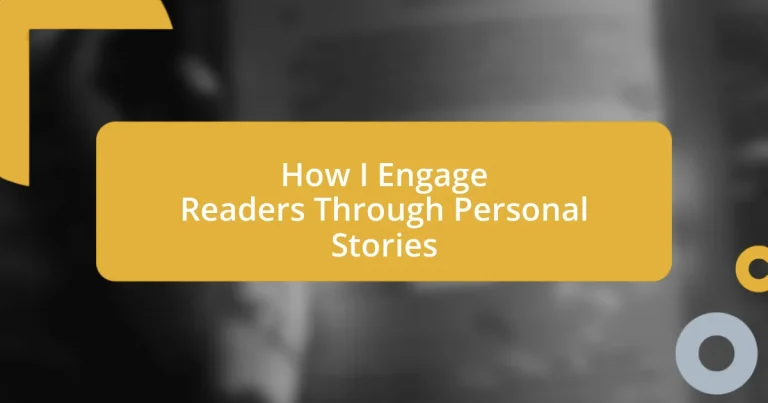Key takeaways:
- Storytelling fosters deep connections by sharing relatable personal experiences, bridging diverse backgrounds through shared emotions.
- Crafting compelling narratives involves authenticity, evoking emotions, highlighting conflicts, and using vivid imagery to engage readers.
- Inviting reader participation enhances dialogue and feedback, transforming readers from passive observers to active participants in the storytelling process.
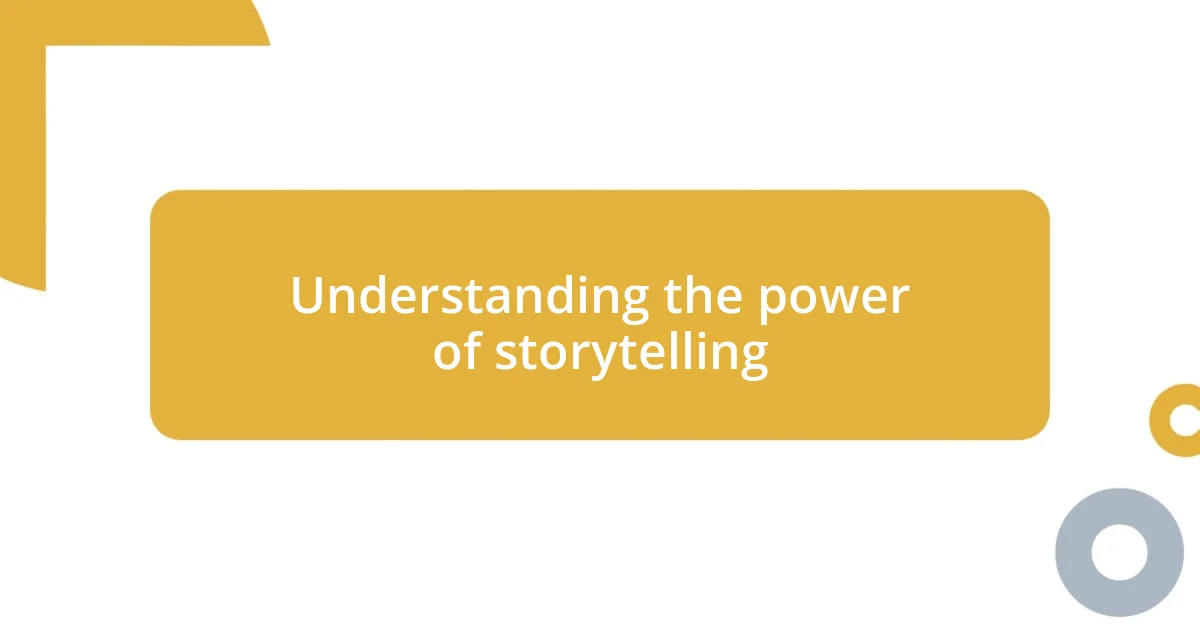
Understanding the power of storytelling
Storytelling has an incredible ability to connect us on a deeper level. I remember a time when I shared a personal failure with a group, and rather than feeling alone, the room filled with nods and murmurs of understanding. It struck me then—how powerful our shared narratives can be.
When we tell personal stories, we invite our listeners into our world, wrapped in emotions and experiences that resonate universally. Have you ever found yourself completely engrossed in a story, feeling the highs and lows as if they were your own? That’s the magic of storytelling; it translates our unique experiences into something relatable, bridging the gap between diverse backgrounds.
Consider how a good story can linger long after the telling. Just last week, I recounted a childhood memory of resilience to my friends over dinner. The laughter and contemplative silence that followed reminded me that these moments we share can inspire and encourage others. Isn’t it fascinating how a simple tale can ignite empathy and understanding in unexpected ways?
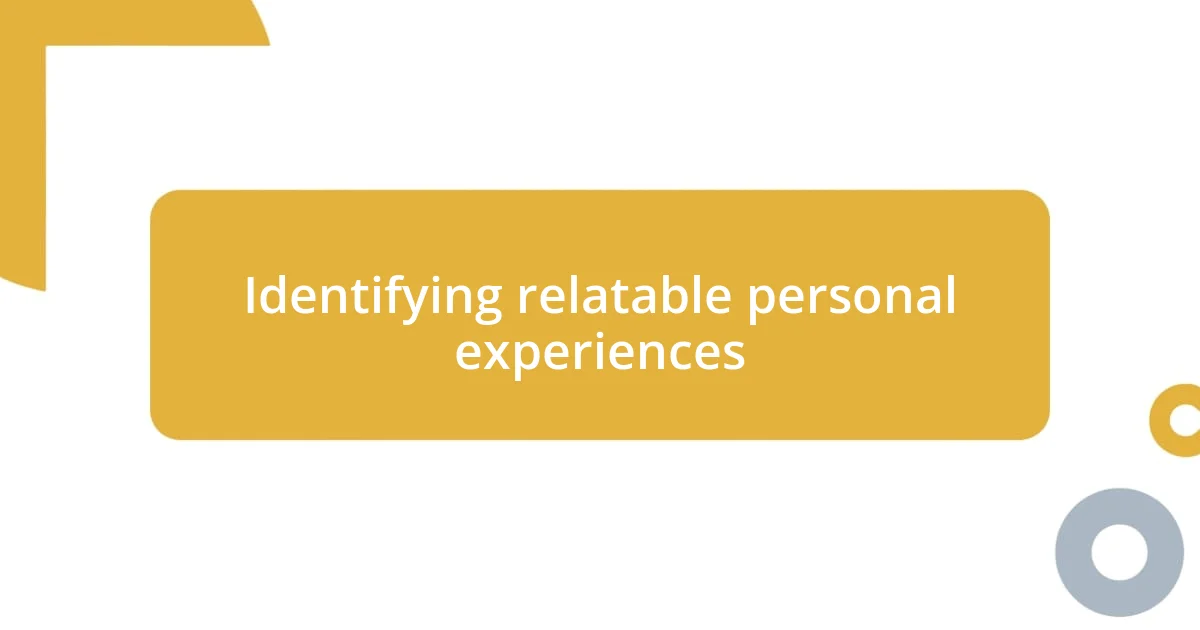
Identifying relatable personal experiences
Identifying relatable personal experiences is key to forging connections with readers. I recall a moment during a tough job hunt when I felt overwhelmed and lost. Sharing that struggle with others not only validated my feelings but also revealed that many had traveled the same rocky road, each of us seeking the same light at the end of the tunnel.
To pinpoint relatable experiences, I often reflect on times when I felt vulnerable or uncertain. For instance, during a challenging breakup, my sense of failure was palpable. I chose to share my journey of healing, sparking conversations with friends who had faced similar heartaches. This exchange allowed us to explore our vulnerabilities and find comfort in shared pain, showing me just how deeply personal experiences can resonate.
When identifying these relatable moments, I think about the emotions they evoke. I once spoke about my struggle with self-confidence before a public speaking event. Sharing my anxieties opened up discussions with others who felt the same, illustrating how these intimate tales can unite us through shared emotions and experiences. The result? A rich tapestry of connection that transforms solitary feelings into collective understanding.
| Experience Type | Relatability Factor |
|---|---|
| Personal Failure | Universally understood |
| Heartbreak | Emotional connection |
| Career Challenges | Shared journey |
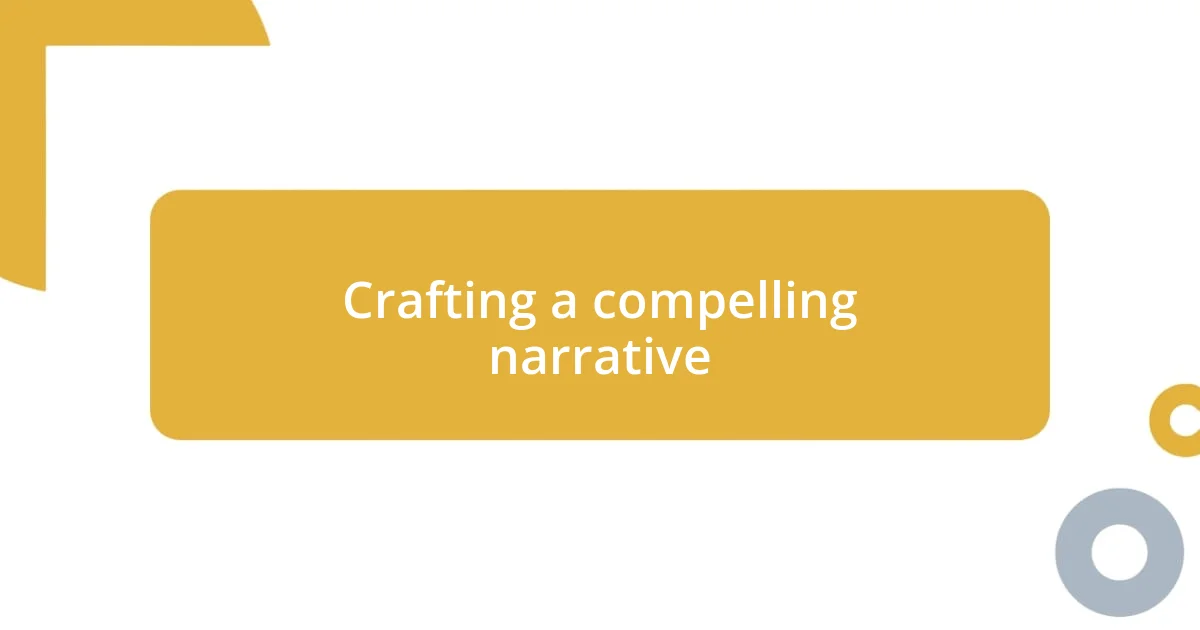
Crafting a compelling narrative
Crafting a compelling narrative isn’t just about the events; it’s about the emotions behind them. I vividly recall a rainy afternoon when I decided to recount my struggle with anxiety in a blog post. The feedback was overwhelming—people shared their own experiences, transforming my vulnerability into a shared moment of solidarity. It reminded me that a narrative can be a powerful catalyst for healing and understanding when we tap into sincere emotions.
To weave together a compelling story, consider these key elements:
- Authenticity: Your genuine experiences resonate best with readers.
- Emotion: Infuse your narrative with feelings that evoke empathy—from joy to sorrow.
- Conflict: Highlighting struggles creates tension, making the story engaging.
- Resolution: Show how you overcame challenges, offering hope and relatability.
- Imagery: Use vivid descriptions to paint scenes that pull readers in.
Each of these aspects allows the reader to travel through your journey with you, turning fleeting moments into lasting connections.

Creating emotional connections with readers
Creating emotional connections with readers means sharing experiences that resonate on a deeper level. I remember attending a friend’s wedding just months after my own divorce. As I watched the couple exchange vows, my heart swelled with conflicting emotions. I shared this poignant moment in my writing, tapping into feelings of joy mixed with bittersweet nostalgia. Questions like, “Have you ever felt torn between happiness for others and your own heartache?” helped readers connect with their own experiences, allowing us to share in that emotional space together.
One time, I opened up about my struggle with imposter syndrome when I was promoted at work. I vividly described that sinking feeling in my stomach as I took on new responsibilities. The insecurity of thinking I wasn’t good enough was overwhelming. By sharing this struggle, I invited others to reflect, “Have you ever felt like a fraud in your own success?” This simple admission created a bond, as countless readers shared similar feelings of self-doubt, creating an environment of trust and understanding.
I’ve also delved into moments of joy, like learning to ride a bike as an adult. The thrill of finally balancing felt like the triumph of overcoming a significant hurdle. I wrote about that exhilarating feeling, framing it within the context of growth and resilience. Through this, I encouraged readers to think back on their own experiences of overcoming obstacles. That joy of conquering fear and feeling free was palpable, offering a collective celebration of achievement and connection.
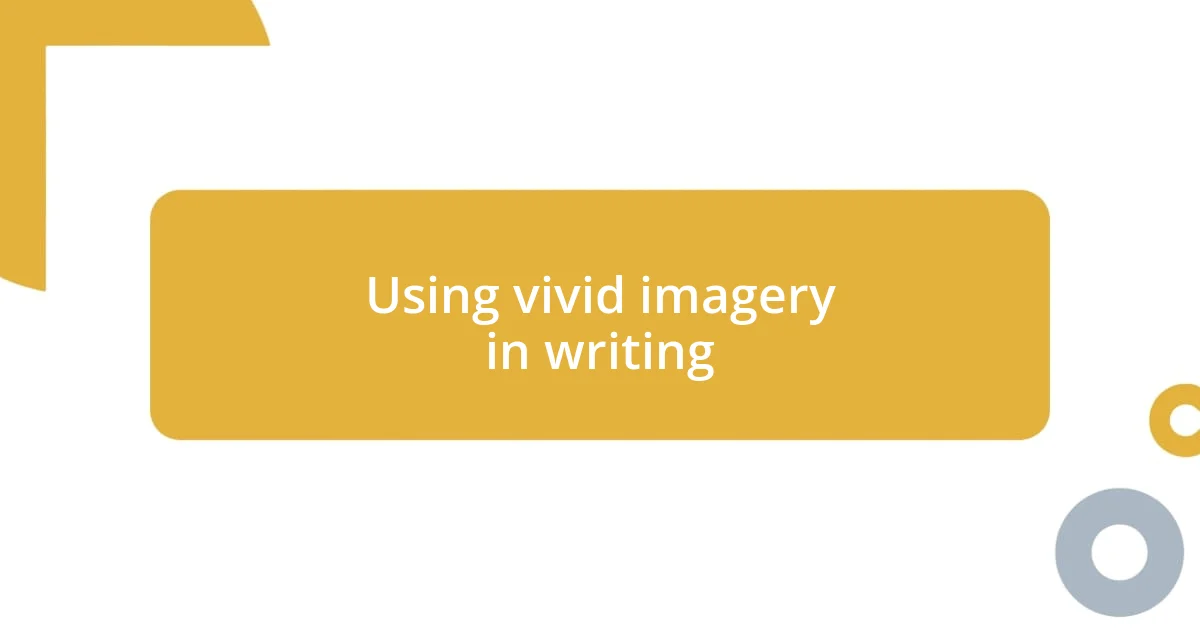
Using vivid imagery in writing
Using vivid imagery in writing can transform a simple narrative into an immersive experience. I remember describing a summer afternoon at my grandmother’s house—her garden was a riot of color, with vibrant red roses and yellow daisies swaying in the gentle breeze. I could almost hear the buzzing of bees amidst the sweet fragrance, inviting readers to join me in that joyful moment. Imagery like this invites readers to not just read about an experience, but to feel it.
Engaging readers through vivid descriptions means tapping into the senses. Once, while writing about a chilly autumn morning, I painted a picture of the crisp leaves crunching underfoot and the golden glow of the sun peeking through the branches. I asked, “Can you remember that feeling of chilly air filling your lungs as you step outside?” This simple question not only conjures memories for my audience, but brings them closer to the scene I’m creating. It’s that sensory connection that makes the narrative stick.
Additionally, emotional imagery can enhance relatability. I once shared a painful moment of loss—standing by the ocean, feeling the waves of grief crashing around me. I described the salty spray on my face and the vast expanse of water mirroring my turbulent feelings. Evoking such imagery helps readers visualize my sorrow, prompting them to reflect on their own losses. Isn’t it intriguing how a shared visual can bridge gaps, making personal experiences feel universal?
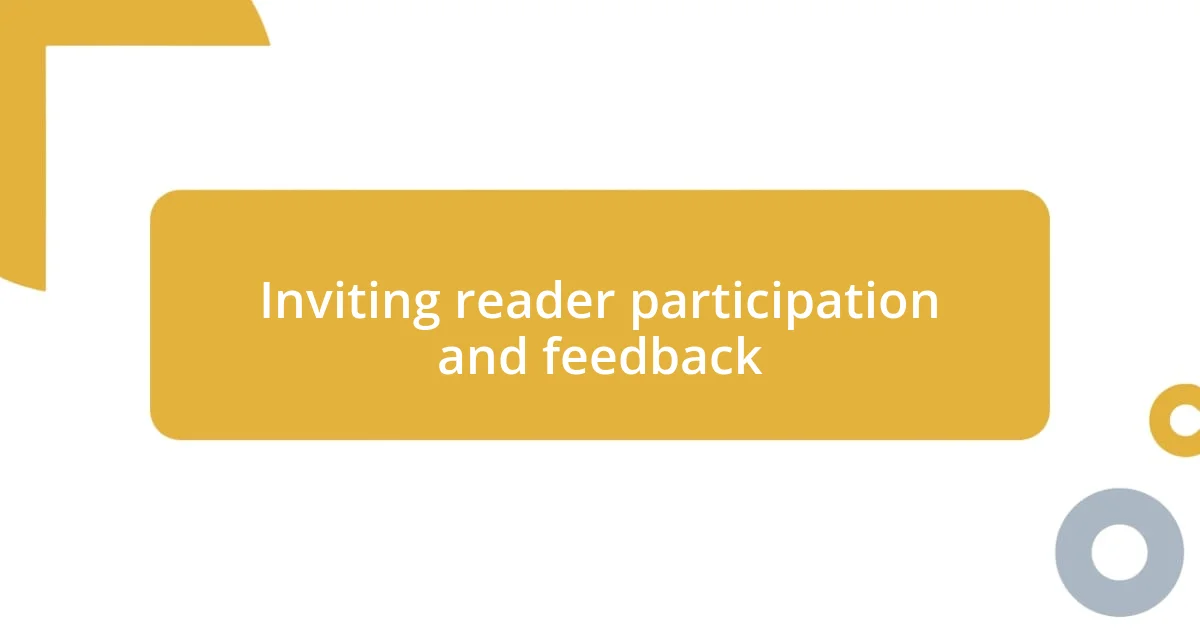
Inviting reader participation and feedback
Inviting readers to participate and share their feedback has always felt like opening the door to a more meaningful dialogue. I recall when I shared a story about a failed attempt at cooking a complicated recipe. I invited readers to comment on their own kitchen disasters, asking, “What’s the most memorable culinary flop you’ve ever had?” The responses poured in, creating a sense of camaraderie among us as we laughed at our shared misadventures.
Encouraging feedback not only fosters connection but also enriches the narrative. Once, I introduced a series about personal growth prompted by challenges in my life and asked readers to write about the biggest obstacles they’ve faced. Their stories were not just feedback—they became a source of inspiration for my future writing. Engaging in this way gives readers a stake in the content, transforming them from passive observers to active participants in the discussion.
When I reflect on the impact of inviting participation, it becomes clear how it enhances my writing. For instance, I once hosted a Q&A about navigating career changes, urging readers to share their uncertainties. I was blown away by the honest conversations that unfolded in the comments. Every shared experience deepened our collective understanding, proving that our stories are interconnected. Isn’t it powerful how vulnerability can create such an open and authentic space for dialogue?
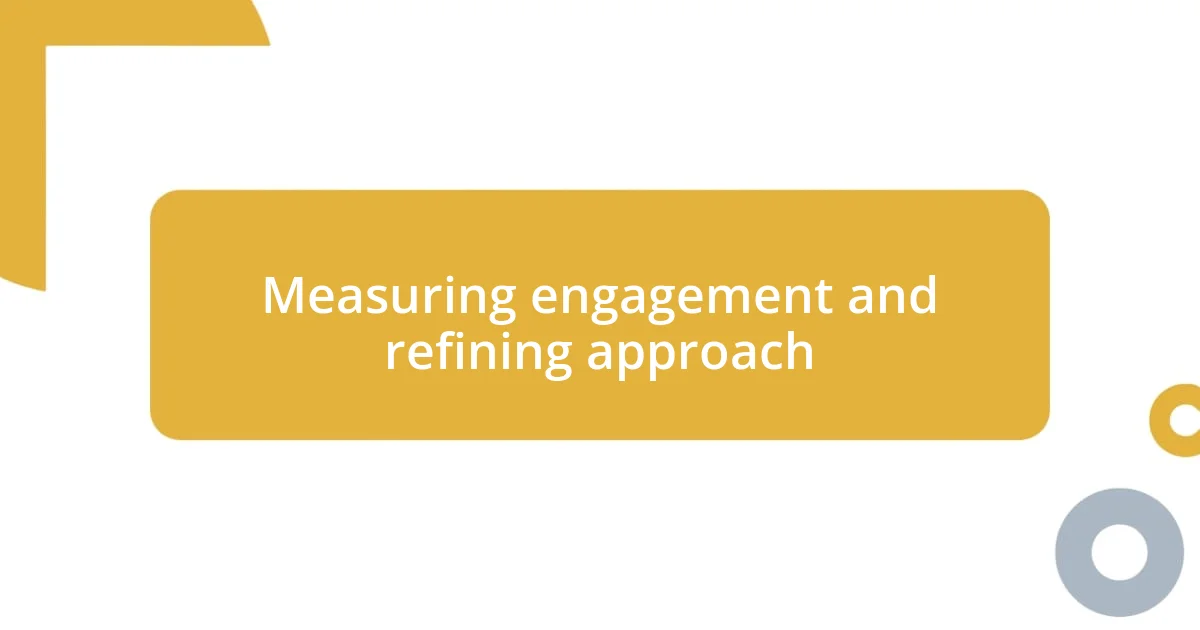
Measuring engagement and refining approach
Measuring engagement is critical to understanding how well my stories resonate with readers. I often track metrics such as comments, shares, and time spent on the page. There was a time when I noticed a drop in comments on stories I thought were captivating. It made me rethink my approach and assess whether the narratives were truly connecting with my audience. Isn’t it surprising how small shifts in reader feedback can lead to significant changes in storytelling?
Refining my approach isn’t just about numbers; it’s about the emotions I evoke. I once wrote about a moment of triumph in completing a challenging marathon, and while the post received decent engagement, the comments revealed that readers felt inspired but not yet motivated. I pondered why some stories didn’t lead to encouragement, and I realized that I hadn’t fully shared the struggles of training. This insight led me to dive deeper into the emotional journey, prompting readers not only to cheer for my success but also to see themselves in my struggles.
Through the lens of personal experience, I find that testing different storytelling techniques is essential to gauge what truly resonates. After shifting my storytelling style to include more vulnerability, I saw a significant uptick in positive engagement. One anecdote about overcoming self-doubt in pursuing my passions prompted heartfelt responses that reminded me how shared vulnerability can create an authentic connection. Have you ever shared a story that unexpectedly struck a chord with others? I believe that such moments not only enhance engagement but also remind us of our shared humanity.












